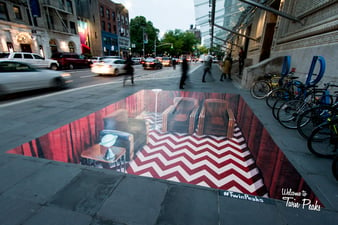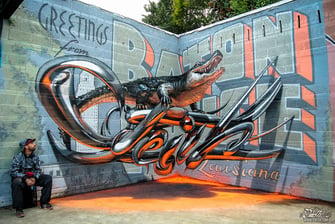Over the last few years, an ancient form of art has resurfaced in the LED Display and Video Content industry. Advancements in LED display technology have given VFX and animation designers a whole new canvas to work on, allowing them to create truly unique viewer experiences. The art form I’m referring to is called anamorphic illusion and you may have seen viral videos of these playing on large digital billboards. Often described as "glasses-free" or 3D "naked eye", anamorphic illusions are generating a lot of buzz, especially on social media.
What is Anamorphosis?
Anamorphosis is a distorted projection requiring the viewer to occupy a specific vantage point, use special devices, or both to view a recognizable image. It is used in painting, photography, sculpture, and films. In today’s motion graphics and VFX world, it means watching video content on a display from a certain position that creates the illusion of a 3- dimensional environment. This is a prime example of where a video can tell a thousand words and create the WOW-factor.
The History of Anamorphic Techniques
Anamorphic technique has come a long way since its humble beginnings. The first documented use was in cave paintings during the stone age that used the oblique angles of the walls to create the illusion. During the Renaissance, it appeared in Leonardo da Vinci’s Leonardo's Eye and Hans Holbein the Younger’s The Ambassadors. The latter is known for its human skull (pictured below). To the casual observer, there is a distorted grey slash in the bottom left of the painting. When viewing from the proper vantage point (the artist suggested a staircase), the skull appears.
Anamorphic illusions then resurfaced in the 17th century in both Italy and China. On the ceiling of the Church of St. Ignazio in Rome, Andrew Pazzo created the appearance of a dome on a flat ceiling. Later on, Edgar Allen Poe makes reference to it in his short story “Lieia”, describing a room filled with "simple monstrosities" that resolve in to "an endless succession of ghastly forms" as the narrator walks through the room. During the First World War, Arthur Mole, an American commercial photographer, used anamorphic techniques to create patriotic images from massive assembled groups of soldiers and reservists. When seen from a tower at their base, the gathered people resolved into recognizable pictures.
Anamorphic Illusion in Everyday Life
Most of us come across the use of anamorphosis in everyday life. Have you ever been to an IMAX theatre? Driven down the road and saw the words “Bus Lane”? Scrolled through social media and stopped on an image of “street art” and did a double take? These are all modern day examples of anamorphic illusions.


The Future of Anamorphic Illusions on Digital Displays
The accelerating commoditization of LED walls is creating a new market for high impact digital art and a playground for 3D and VFX designers. Breathtaking visual content for digital out of home (DOOH) is not only a big opportunity for brands to draw in viewers to a specific location (typically a busy public space) but it presents an even bigger opportunity for online viral marketing.
Trending examples of anamorphic illusions are being used in video advertisements and have started to circulate through the internet. London England’s Piccadilly Circus has a new LED Billboard that is being used to promote everything from new TV Series to watches to cars. Viral videos of “The Wave” and the “Infinity Wall” from East Asia followed by “The Whale” in Times Square have everyone buzzing. It's obvious to see why!
With buzz comes creation and ideas. New animation techniques coupled with the fact that large format LED displays are now being used everywhere, we'll start to see more and more anamorphic illusions to create high impact viewing experiences in various environments from trade shows to corporate lobbies and shopping malls to airports. As LED display technology continues to advance, so will the content. Anamorphic illusions will continue to play a key role and I know I’m excited to see the next stage in its evolution! Our team here at Render Impact has created content for several anamorphic illusion projects and has more in the pipeline for 2022 so stay tuned!
Interested in anamorphic illusion content for your next digital display project? Contact us today to learn more.
